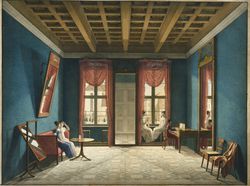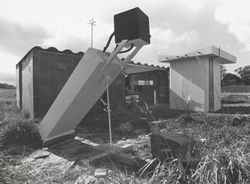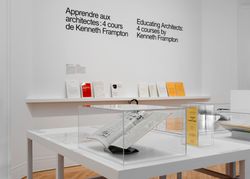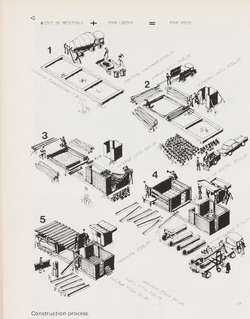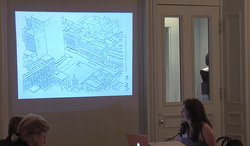textual records
AP197.S3.006
Description:
The box is comprised of correspondence for the years of 1995-1997, organized in chronological order. The box documents Frampton’s career as Ware professor at the Graduate School of Architecture, Planning and Preservation, Columbia University and his related professional activities. Correspondence in this box includes: offers of teaching positions; requests to write articles, reviews, books and recommendation letters; invitations to teach, present, or attend at lectures/symposiums/conferences; and requests to serve on juries. Throughout this period, Frampton corresponded with various architects, professors, publishers, and editors of various publications such as: Thames and Hudson Ltd.; the Berlage Institute; the Italian Cultural Institute; Yukio Futagawa of GA/ADA Edita Tokyo Co CD; and the MIT Press. Correspondence relates to his participation/involvement in: the Michael Blackwood Production “In search of Louis Kahn: Six Buildings;” the Japanese and German translations for the Studies in Tectonic Culture publication; organizing lectures on Studies in tectonic Culture; the Jerusalem Seminar in Architecture “Technology, Place & and Architecture;” teaching at the École polytechnique fédérale de Lausanne; the Aga Khan Program for Islamic Architecture; and the Architectural Society of China. Correspondence concerning the following publications and lectures is included: “the Megaform as City in Miniature;” “Critical regionalism revisited,” a lecture at the Berlage Institute; the Le Corbusier publication; “Tradition and Innovation in the Work of Christoph Mackler;” and the forward for Vittorio Gregotti`s Inside Architecture.
1995-1997
Personal and professional correspondence from 1995-1997
Actions:
AP197.S3.006
Description:
The box is comprised of correspondence for the years of 1995-1997, organized in chronological order. The box documents Frampton’s career as Ware professor at the Graduate School of Architecture, Planning and Preservation, Columbia University and his related professional activities. Correspondence in this box includes: offers of teaching positions; requests to write articles, reviews, books and recommendation letters; invitations to teach, present, or attend at lectures/symposiums/conferences; and requests to serve on juries. Throughout this period, Frampton corresponded with various architects, professors, publishers, and editors of various publications such as: Thames and Hudson Ltd.; the Berlage Institute; the Italian Cultural Institute; Yukio Futagawa of GA/ADA Edita Tokyo Co CD; and the MIT Press. Correspondence relates to his participation/involvement in: the Michael Blackwood Production “In search of Louis Kahn: Six Buildings;” the Japanese and German translations for the Studies in Tectonic Culture publication; organizing lectures on Studies in tectonic Culture; the Jerusalem Seminar in Architecture “Technology, Place & and Architecture;” teaching at the École polytechnique fédérale de Lausanne; the Aga Khan Program for Islamic Architecture; and the Architectural Society of China. Correspondence concerning the following publications and lectures is included: “the Megaform as City in Miniature;” “Critical regionalism revisited,” a lecture at the Berlage Institute; the Le Corbusier publication; “Tradition and Innovation in the Work of Christoph Mackler;” and the forward for Vittorio Gregotti`s Inside Architecture.
textual records
1995-1997
research
TD Bank Group-CCA Collection Research Grant Recipients: Pep Avilés (Princeton University); Julia Morgan Charles (McGill University); Duks Koschitz (Massachusetts Institute of Technology); Alessandra Mariani (UQàM - Université du Québec à Montréal); Andrea Merrett (Columbia University); Yetunde Olaiya (Princeton University); Daria Ricchi (Princeton University); Todd Satter(...)
June 2012 to August 2012
Doctoral Students Program 2012
Actions:
Description:
TD Bank Group-CCA Collection Research Grant Recipients: Pep Avilés (Princeton University); Julia Morgan Charles (McGill University); Duks Koschitz (Massachusetts Institute of Technology); Alessandra Mariani (UQàM - Université du Québec à Montréal); Andrea Merrett (Columbia University); Yetunde Olaiya (Princeton University); Daria Ricchi (Princeton University); Todd Satter(...)
research
June 2012 to
August 2012
Seeing, perceiving, viewing, envisioning: each is a form of framing that mediates between inside and outside, public and private, what’s evident and what’s hidden. Georges Teyssot, Professor at Université Laval’s School of Architecture in Quebec City and author of A Topology of Everyday Constellations (The MIT Press, 2013), analyzes how the notions of window, door, frame,(...)
Shaughnessy House
19 February 2015 , 6pm
Windows and Screens: Georges Teyssot
Actions:
Description:
Seeing, perceiving, viewing, envisioning: each is a form of framing that mediates between inside and outside, public and private, what’s evident and what’s hidden. Georges Teyssot, Professor at Université Laval’s School of Architecture in Quebec City and author of A Topology of Everyday Constellations (The MIT Press, 2013), analyzes how the notions of window, door, frame,(...)
Shaughnessy House
In the Yesterday Today lecture series, Canadian architect and author Witold Rybczynski discusses the roots of Ecol House, a prototype for an autonomous dwelling for use in developing countries. The project was created in Montréal in 1972 by Ecol Operation, a group of architects and students of which he was a member that became an international point of reference for(...)
Paul-Desmarais Theatre
29 November 2007
Witold Rybczynski: Green Before Green
Actions:
Description:
In the Yesterday Today lecture series, Canadian architect and author Witold Rybczynski discusses the roots of Ecol House, a prototype for an autonomous dwelling for use in developing countries. The project was created in Montréal in 1972 by Ecol Operation, a group of architects and students of which he was a member that became an international point of reference for(...)
Paul-Desmarais Theatre
research
TD Bank Group-CCA Collection Research Grant recipients: Jordan Kauffman (Massachusetts Institute of Technology); Julia Tischer (McGill University); Mariana Mogilevich (Harvard University); Elizabeth McFarland (Cornell University); Alexandra Quantrill (Columbia University); Enrique Ramirez (Princeton University); Yoonchun Jung (McGill University); Mark Clintberg (Concordia(...)
February 2011 to November 2011
Doctoral Students Program 2011
Actions:
Description:
TD Bank Group-CCA Collection Research Grant recipients: Jordan Kauffman (Massachusetts Institute of Technology); Julia Tischer (McGill University); Mariana Mogilevich (Harvard University); Elizabeth McFarland (Cornell University); Alexandra Quantrill (Columbia University); Enrique Ramirez (Princeton University); Yoonchun Jung (McGill University); Mark Clintberg (Concordia(...)
research
February 2011 to
November 2011
Amid education reform in American schools of architecture in the 1970s, Kenneth Frampton was integral in transforming the curriculum of Columbia University’s Graduate School of Architecture Planning. In particular, he designed and taught what became three core courses: the theory seminar “Comparative Critical Analysis,” the history lectures “Thresholds of Modern(...)
31 May 2017 to 24 September 2017
Educating Architects: Four Courses by Kenneth Frampton
Actions:
Description:
Amid education reform in American schools of architecture in the 1970s, Kenneth Frampton was integral in transforming the curriculum of Columbia University’s Graduate School of Architecture Planning. In particular, he designed and taught what became three core courses: the theory seminar “Comparative Critical Analysis,” the history lectures “Thresholds of Modern(...)
The three recipients of this years Power Corporation of Canada Award, Lisa Chow (McGill University), Michèle Curtis (Carleton University), and Geneviève Depelteau (University of British Columbia), present the findings of their three-month research residency at the CCA, during which they studied the rise of an environmental consciousness in architecture and landscape(...)
Shaughnessy House
1 September 2016, 6pm
Is the Problem... Still the Environment?
Actions:
Description:
The three recipients of this years Power Corporation of Canada Award, Lisa Chow (McGill University), Michèle Curtis (Carleton University), and Geneviève Depelteau (University of British Columbia), present the findings of their three-month research residency at the CCA, during which they studied the rise of an environmental consciousness in architecture and landscape(...)
Shaughnessy House
2016 Visiting Scholar Olumuyiwa Adegun presents his research: European cities of the nineteenth century, like African cities today, experienced severe housing problems. Shanty towns marked Berlin and Paris in ways that are similar to how Nairobi and Johannesburg have been characterized by informal settlements in the last few decades. This lecture explores the history of(...)
Shaughnessy House
4 August 2016, 6pm
Visiting Scholar Seminar: Olumuyiwa Adegun
Actions:
Description:
2016 Visiting Scholar Olumuyiwa Adegun presents his research: European cities of the nineteenth century, like African cities today, experienced severe housing problems. Shanty towns marked Berlin and Paris in ways that are similar to how Nairobi and Johannesburg have been characterized by informal settlements in the last few decades. This lecture explores the history of(...)
Shaughnessy House
Michela Rosso, 2013 Support Grant Recipient, presents her research from Peter Carter’s archive on the Mansion House square scheme (1962–1985) and shows the different facets of the controversy over Mies van der Rohe’s unbuilt tower in the heart of the City of London. Rosso holds a doctorate from the Politecnico di Torino, where since 2003 she has been Associate professor(...)
Shaughnessy House
30 May 2013, 6pm
Friends and Enemies of Mies’s Mansion House Square
Actions:
Description:
Michela Rosso, 2013 Support Grant Recipient, presents her research from Peter Carter’s archive on the Mansion House square scheme (1962–1985) and shows the different facets of the controversy over Mies van der Rohe’s unbuilt tower in the heart of the City of London. Rosso holds a doctorate from the Politecnico di Torino, where since 2003 she has been Associate professor(...)
Shaughnessy House
Learning from... Mumbai
Rahul Mehrotra presents a reading of Mumbai’s form as a symbol of India’s emerging urban culture. The lecture examines Mumbai, a megalopolis with more than 13 million inhabitants, as two distinct elements that occupy the same physical space. The first, the Static City, built of permanent materials like concrete, steel and brick, can be captured as a two-dimensional entity(...)
Paul Desmarais Theatre
9 April 2009
Learning from... Mumbai
Actions:
Description:
Rahul Mehrotra presents a reading of Mumbai’s form as a symbol of India’s emerging urban culture. The lecture examines Mumbai, a megalopolis with more than 13 million inhabitants, as two distinct elements that occupy the same physical space. The first, the Static City, built of permanent materials like concrete, steel and brick, can be captured as a two-dimensional entity(...)
Paul Desmarais Theatre
